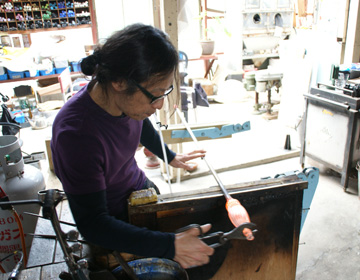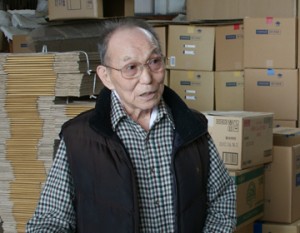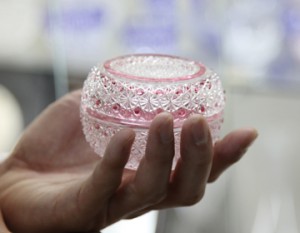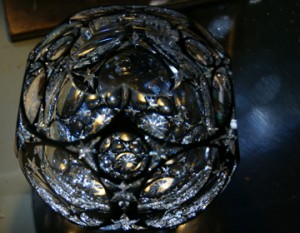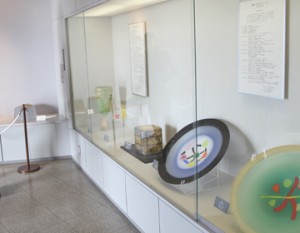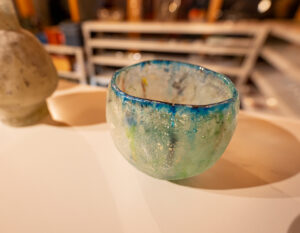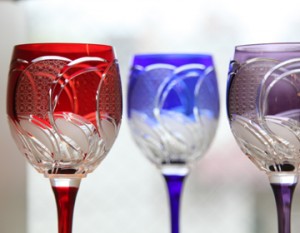Transformation like magic
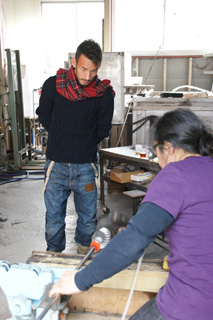
Glasswork artist Yoshihiko Takahashi is currently a professor at Tama Art University. He is a world renowned artist who has experience working at a glasswork studio in Germany, and presents his works through exhibitions abroad. We were able to watch him work at his studio which he opened in 1985.
He explained to Nakata as he kept on working on the lump of glass. It transformed before our eyes. The only time he blew into the glass was to make the glass round. ”The glass stretches with its own weight,” Takahashi explained as he swung the blowpipe downward, the molten glass elongating. He used just the centrifugal force, without using any other tools to open the mouth of the vessel. He senses the temperature of the glass, ductility, gravity, and centrifugal force to form his pieces. The glass transformed like magic, and was quite impressive. ”Nowadays, you can use various tools in glasswork. They are very convenient, but I couldn’t find a satisfying reason to use these tools so I made my own rules.” The first rule was to use blowpipes to melt the glass. The second rule was to create the glasswork within the first rule. ”For example, the bottom of the glass are often shaven as a finishing touch. I prefer not to do that, so I quit doing it.” Just as Takahashi said, the pieces he created had the soft curves and smooth surface that was made them beautiful.
Experiencing glasswork
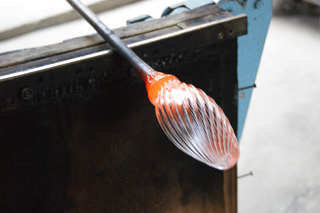
Next was Nakata’s turn. Nakata was given a blowpipe which he put into the fire. Takahashi then pulled it out of the fire saying, ”Let’s blow the glass when the time is right.” ”When is that?” asked Nakata hesitantly. ”Right now,” Takahashi replied. ”Okay, that’s good. Now, swing it like a pendulum.” As Nakata swung the blowpipe, the glass bubble elongated and the shape of a drinking glass appeared. Nakata kept turning the blowpipe as Takahashi carefully monitored the temperature of the glass. Nakata enjoyed the unique movement of the glass material. It is something you cannot truly appreciate by just watching someone else do the work. Nakata’s work became a large drinking glass. It turns out that Takahashi has been focusing on making drinking glasses.
Making glass cups
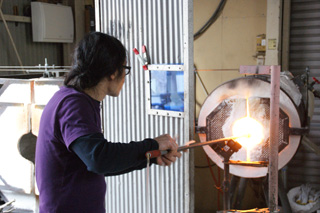
”I had the opportunity to work with Shigesato Itoi’s office the other day, and we decided to do an exhibition of every day drinking glasses which was also introduced on the web. Drinking glasses reveal a lot, since you come into direct contact with them using your hands and mouth. In a way, they have a very high standard. This is why I have been making only drinking glasses these days.”
His words were quite unexpected. ”High standards” ”Very revealing” Its true that when you place a glass against your mouth, the thickness of the rim can be bothersome.
Being able to see something about your work that isn’t visible when its a piece of art, may actually help better your understanding of that item.
”Everyone has their own preference when it comes to the type of drinking glass they like to use, so it’s best to make each glass, one by one. Like a local baker, the relationship with the customer is important.”
”You mean you want to make each piece to order?”
”Yes. Like architects. I think vessel makers are like that.”
Takahashi has long been making art objects and unique shapes. Now he creates drinking glasses as he draws out one of the key characteristics and features of the material, ”glass.”



